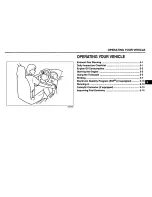
conditions of the vehicle, helps in locating
faults and improving quality, and is trans-
ferred to the vehicle manufacturer, if neces-
sary.
Furthermore, the manufacturer has product
monitoring obligations to meet in line with
product liability law. To fulfil these obliga-
tions, the vehicle manufacturer requires
technical data from the vehicle. Error and
event memories in the vehicle can be reset
when a Service Partner of the manufacturer
or another qualified Service Partner or a
specialist workshop performs repair or serv-
icing work.
Data on service work carried out and proof
of maintenance is saved in the vehicle un-
der the service history and transferred to
the vehicle manufacturer. The vehicle
owner can contact a Service Partner of the
manufacturer to object to the data being
saved and transferred to the vehicle manu-
facturer. This objection applies for as long
as the vehicle owner remains the proprietor
of the vehicle.
Data entry and data transfer into
the vehicle
General
Depending on the equipment, some data can
be transferred into the vehicle when using
comfort and infotainment functions, for ex-
ample:
–
Multimedia data such as music or films
for playback in an integrated multimedia
system.
–
Address book data for use in conjunc-
tion with an integrated hands-free sys-
tem or an integrated navigation system.
–
Entered navigation destinations.
–
Data on the use of Internet services.
This data may be saved locally in the vehi-
cle or is found on a device that has been
connected to the vehicle, for example a
smartphone, USB stick or MP3 player. If this
data is saved in the vehicle, it can be de-
leted at any time. This data is only transmit-
ted to third parties if expressly desired. This
depends on the personal settings selected
for using online services.
Depending on the equipment, the following
comfort and individual settings can be
saved in the vehicle and modified at any
time, for example:
–
Settings for the seat and steering wheel
positions.
–
Suspension and climate control settings.
–
Individual settings, for example interior
lighting.
Control via mobile end user devices
Depending on the equipment, mobile devi-
ces connected to the vehicle, for example
smartphones, can be controlled via the vehi-
cle controls. Sound and images from the mo-
bile end user device can be played back and
displayed through the multimedia system.
Certain information is transferred to the
mobile device at the same time. Depending
on the type of connection, this includes,
for example position data and other general
vehicle information. This optimises the way
in which selected apps, for example naviga-
tion or music playback, work.
There is no further interaction between the
mobile device and the vehicle, for example
active access to vehicle data. How the data
is processed further is determined by the
provider of the particular app being used.
The range of settings depends on the re-
spective app and the operating system of
the mobile device.
Services
General
If the vehicle has a wireless network con-
nection, this enables data to be exchanged
Seite 12
NOTES
Notes
12
Online Edition for Part no. 01402988211 - II/18
Draft
from
BA-76
Summary of Contents for COUNTRYMAN 2018
Page 2: ...Online Edition for Part no 01402988211 II 18 D r a f t f r o m B A 7 6 ...
Page 14: ...14 Online Edition for Part no 01402988211 II 18 D r a f t f r o m B A 7 6 ...
Page 30: ...30 Online Edition for Part no 01402988211 II 18 D r a f t f r o m B A 7 6 ...
Page 54: ...54 Online Edition for Part no 01402988211 II 18 D r a f t f r o m B A 7 6 ...













































